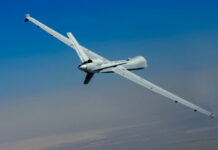The US Marine Corps (USMC) has recently received the first of eight new-build General Atomics Aeronautical Systems Inc (GA-ASI) MQ-9A Reaper Extended Range (ER) unmanned aerial vehicles (UAVs) delivered under a joint contract with the US Air Force (USAF), US Naval Air Systems Command (NAVAIR) announced on 10 May 2023.
A GA-ASI press release on 16 May noted that the first MQ-9A ER was delivered to NAVAIR on 19 April.
The delivery of the first new-build MQ-9A ER is part of the Marine Air-Ground Task Force (MAGTF) Unmanned Expeditionary (MUX) Program: a key component of Marine Corps Force Design 2030. In 2022 the US Navy’s Multi-Mission Tactical Unmanned Air System programme team (PMA-266) at Pax River leveraged the USAF’s Agile Reaper Enterprise Solution (ARES) – an indefinite-delivery, indefinite-quantity (IDIQ)-type contract – to order eight USAF MQ-9 ER UAVs for the MUX programme, along with associated spares and support equipment.
“The US Air Force has been a great partner and a major enabler in the Marine Corps’ pursuit to acquire Group 5 unmanned aerial systems (UAS),” Lieutenant Colonel Leigh Irwin, the USMC’s MQ-9 programme director for PMA-266, was quoted as saying by NAVAIR. “Group 5 UAS will give the Marines the ability to conduct ISR [intelligence, surveillance and reconnaissance] and network extensions in support of the MAGTF in support of stand-in forces and the Joint Force.”

Marine Unmanned Aerial Vehicle Squadron (VMU)-1 in Yuma will utilise this aircraft for operational missions overseas, she said.
The MQ-9 Reaper is filling an immediate need for a long-range, long-endurance, land-based Group 5 UAS to conduct ISR and data relay in the Indo-Pacific Command area of responsibility.
“The MQ-9A ER is designed with field-retrofittable capabilities such as wing-borne fuel pods and reinforced landing gear that extend the aircraft’s endurance to more than 30 hours while further increasing its operational flexibility,” GA-ASI noted in its press release. “The aircraft provides long-endurance, persistent surveillance capabilities with full-motion video and synthetic aperture radar/moving target indicator/maritime mode radar.
“An extremely reliable aircraft, MQ-9A ER is equipped with a fault-tolerant flight control system and a triple-redundant avionics system architecture,” GA-ASI added. “It is engineered to meet and exceed manned aircraft reliability standards.”
The USMC currently has two operational MQ-9A aircraft that were procured upon the successful completion of a company-owned company-operated (COCO) deployment contract fulfilled by GA-ASI. These support a wide range of operations such as coastal and border surveillance, weapons tracking, embargo enforcement, humanitarian assistance /disaster relief, peacekeeping and counter-narcotic operations.
Peter Felstead











